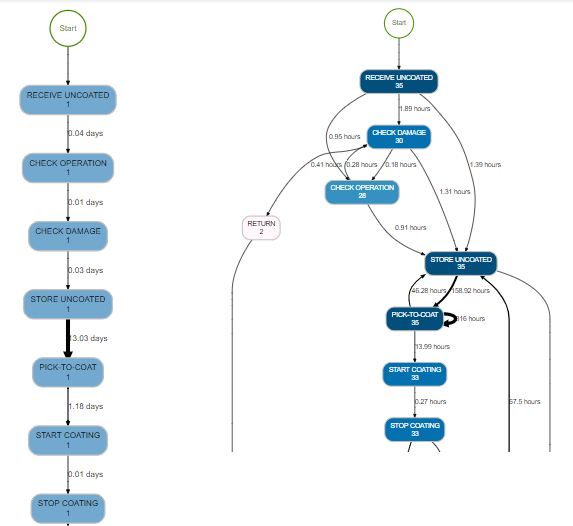In the previous post, we had briefly discussed process mining and explained why it is essential for a company. In this post, we will discuss how process mining helped derive more information/insights for a fictitious Smartphone coating company.
**This article is written from a consultant’s perspective to give you insights into how process mining can help you in real-case business situations.
Mary is the CEO of Shield Coat Inc. Mary shortly describes her company and provides information about the process at Shield Coat Inc. She is very curious about how process mining will offer her new insights using her ERP system. Frank, a consultant from LatentView Analytics, explains to Mary about the event log created from Shield Coat’s ERP data. He helps her visualize the real process discovered via process mining.
Mary: Hi Frank, last time when we spoke on the phone, you were telling me about this exciting area of Process Mining as a way to glean process-related insights. I think there might be a need for something like this in my organization. Can you tell me something more?
Frank: Sure, Mary. Nice to catch up with you!. I would love to discuss aspects of Process Mining and its relevance to your situation. Before I get started, can you give me a broad idea of your situation?
Mary: Yes, Frank. Here’s a brief overview of the company’s business process:
| Company: | Shield Coat Inc. |
| Job: | Makes sure that smartphones are waterproof |
| How: | Apply Nano-coating on a smartphone. |
| Customers: | Imart, Mobile Market, and Mobile House |
| Business process: | Receive and check the uncoated smartphones; Coating and testing them; Shipping the coated smartphones back to customers. |
| Resources: | 1 coater, 2 test engineers, 3 warehouse worker, and CEO |
Process Discovery:
Mary: How can I discover the journey of smartphones throughout the process?
Frank: We have created a solution to monitor & address the process efficiency issue that is widely prevalent across industries.
Thanks to LatentView’s process mining tool, we can instantly visualize the journey of all smartphones. From the process map, we immediately notice that the process starts with 35 smartphones and that only 27 smartphones are finally shipped to the retailer. We also instantly see that the real process is not that linear, which means that the journeys are not always similar for all smartphones.
Mary: Oh! That’s surprising. I always believed our process flow to be linear. Are there too many variations? I wonder whether one path occurs more frequently than the others.
Frank: There are 18 variants. This means that amongst all 35 smartphone journeys, 18 different paths were followed. Below we see that 17 smartphones follow the 5 most frequent paths (variants). To summarize, these 5 paths cover 55% of all 35 smartphone journey

Process Deviations:
Frank: Mary, all received uncoated smartphones need to be checked for damage and then operation before storage. However, there are some cases where the initial checks are not performed in the reverse order.

Mary: That’s not what I expected. These tests are to be followed in a proper sequence. I wonder who forgot to perform these tests.
Frank: Thomas and Arthur are the resources responsible for these tests. Thomas never forgets the inbound controls, and he performs all the activities in order(‘check damage’ followed by “check operation’). Arthur, on the other hand, has not performed the initial checks for the 5 smartphones. Also, for 11 cases, he has performed Check Operation before Check Damage.

Frank: Also, all coated smartphones need to be tested (‘Test 1′ followed by “Test 2′, followed by “Test 3’ – only for Imart phones) before they are shipped. There is one case where the tests are not performed in the proper sequence.
Compliance:
Mary: I didn’t realize that the business process had these many flaws. Are there any other smartphones that don’t obey the process compliance?
Frank: 1 Smartphone was rejected only after both the tests were completed. It was not proposed for scrapping, and it ended in the activity Store Uncoated. The initial checks and tests were not performed properly. Also, for “Phone 3678 “, the cooldown period is not respected, and initial tests are performed in a random sequence, and for “Phone 3670 “, the cooldown period is not respected, and initial tests are not at all performed.
Resource Analysis
Frank: James (Warehouse Assistant) takes more time to complete his activity than any other resource, followed by yourself and Elizabeth (Test Engineer).
Mary: Is that so? I evaluate smartphones and decide whether they are scrapped or not once the coating process is done.
Frank: Yes, but it was found that you always evaluate scrapings only on Sundays. This might slow down the process, especially in cases, you reject the proposal.
Mary: Oh! On-time delivery is crucial for customer satisfaction. I will make sure that I evaluate smartphones now and then.
Frank: Once a smartphone is coated, a cooldown period of 24 hours is required before the tests can start. Harry has not respected the cooldown period for 4 smartphones. Hence the average time taken by Harry is less when compared to his counterpart Elizabeth.
Mary: Cooldown period is an important metric to ensure the quality of smartphones. Is there any possible way to reduce costs?
Frank: You mentioned earlier that Imart smartphones require an additional test. Hence the Case duration is a bit higher for Imart smartphones when compared to the other brands. Also, both coated and uncoated smartphones remain quite a long time in the Warehouse. Since storage costs money and on-time delivery are important to perform better than competitors, I advise you to speed up the process.
Process Drilldown:
Frank: Bee Phones take more time to complete their journey than Neon. It is because of the following reasons:
- The mean time to coat a Bee Phone almost takes twice the time to coat a Neon phone. It might indicate that the coating process for Bee Phones is much more complicated.
- “Test 3 “is performed 8 times for Bee Phone (Imart smartphones requires an additional test), whereas Neon doesn’t have any smartphones from the customer Imart, thereby having lesser throughput time.
- Bee Phones(21%) are relatively more often scrapped than Simsongs (8%).
Mary: Thank you for your feedback, Frank. The information/insights from your process mining tool were tangible, easy-to-understand, and pragmatic. I could clearly understand the importance of Process mining.
Frank: You are welcome, Mary. I am glad that you found process mining as a valuable tool/asset for your operations.





